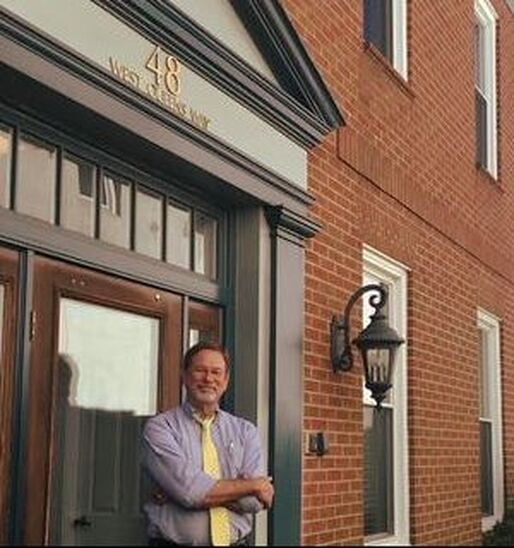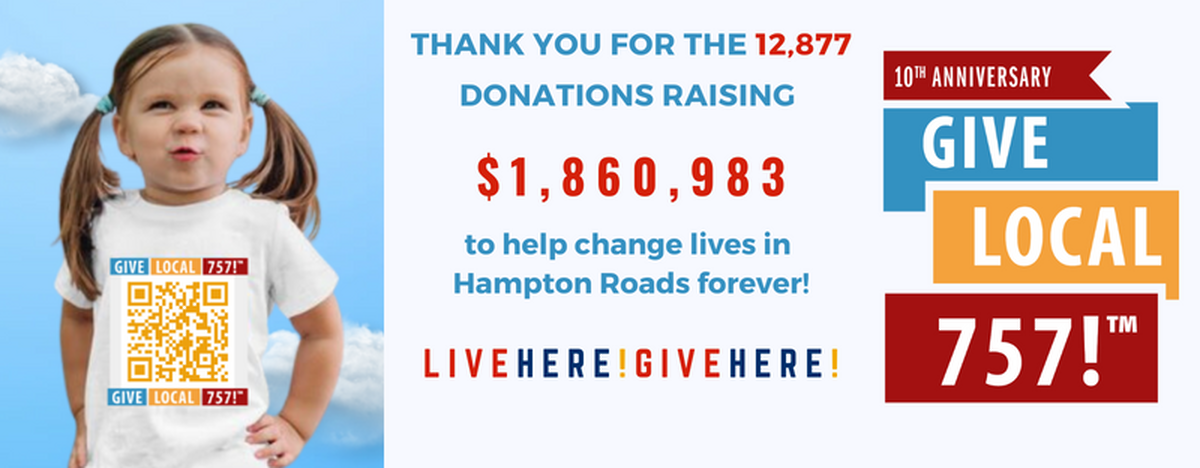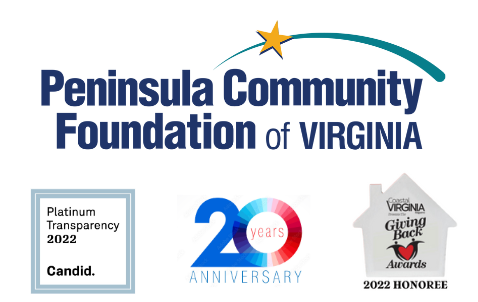The power of the IRA beneficiary designation, the IRS's bigger budget, and not-to-miss news and trends
|
Hello and Happy May!
Springtime has arrived in our region! We hope you are enjoying the change in seasons and warmer weather. On April 25 we completed our very successful one day of giving which we call “Give Local 757”. I am happy to report that we raised over $1.8 million for more than 200 local nonprofits. Thank you for helping make this a wonderful day and for strengthening our nonprofit community. As you emerge from a busy tax season, your attention is probably turning to estate and financial planning for your clients. How to capture charitable bequests through IRA beneficiary designations is something we are thinking about and maybe, like us, you're also watching and wondering how the IRS's increased budget may affect your high income-earning clients and their charitable giving plans. We're covering all of those topics in this newsletter. |
As always, the Peninsula Community Foundation is here to help you and your clients navigate the various options for charitable giving. We’ll help give you the insights and confidence you need to develop plans that enable your clients to provide the charitable support they intend while also keeping the clients’ activities well within the boundaries of the law.
It is our honor and pleasure to work with you and your clients. We look forward to talking with you soon!
Michael Monteith
CEO, Peninsula Community Foundation of Virginia
It is our honor and pleasure to work with you and your clients. We look forward to talking with you soon!
Michael Monteith
CEO, Peninsula Community Foundation of Virginia
Retirement plans to charity: Understanding the “trifecta” of tax benefitsOver the last few months, many advisors have noticed an uptick in client inquiries about leaving their IRAs and other retirement plans to charity. If you’re wondering why, it likely has a lot to do with the buzz about Qualified Charitable Distributions, which allow those who’ve reached the age of 70 ½ to direct up to $100,000 annually to qualified charities (such as a designated or field-of-interest fund at the community foundation), avoiding both the need for an RMD (if they’ve reached age 73) and the income tax hit.
It’s probably more than just the QCD, though, that has spurred your clients to ask questions. More and more, charitable planning with IRAs and other qualified retirement plans is a topic in financial and mainstream media. A case in point is a September 2022 article in the Wall Street Journal, irresistibly titled “Win an Income-Tax Trifecta With Charitable Donations.” If you subscribe to the Wall Street Journal, the article is well worth your time. |
When your client names a public charity, such as a donor-advised or other fund at the community foundation, as the beneficiary of a traditional IRA or qualified employer retirement plan, your client achieves extremely tax-efficient results.
Here’s why:
First of all, the client achieved tax benefits over time as the client contributed money to a traditional IRA (or to an employer-sponsored plan). That’s because contributions to certain retirement plans are what the IRS considers “pre-tax”; your client does not pay income tax on the money used to make those contributions (subject to annual limits).
Second, assets in IRAs and qualified retirement plans grow tax free inside the plan. In other words, the client is not paying taxes on the income generated by those assets before distributions start in retirement years. This allows these accounts to grow rapidly.
Third, when a client leaves a traditional IRA or qualified plan to a fund at the community foundation or another charity upon death, the charity does not pay income taxes (or estate taxes) on those assets. By contrast, if the client were to name children as beneficiaries of an IRA, for example, those IRA distributions to the children are subject to income tax, and that tax can be hefty given the tax treatment of inherited IRAs.
So, if your client is deciding how to dispose of stock and an IRA in the client’s estate plan, intending to leave one to children and the other to charity, leaving the IRA to charity and the stock to children is a no-brainer. Remember, the client’s stock owned outside of an IRA gets the “step-up in basis” when the client dies, which means that the children won’t pay capital gains taxes on the pre-death appreciation of that asset when they sell it.
Here’s the net-net:
Traditional IRAs are often poor vehicles for your clients to use to leave a family legacy. Instead, if a client is charitably inclined, traditional IRAs are likely better deployed to posthumous philanthropy if other assets, such as appreciated stock, are available to leave to children and other heirs.
The community foundation is always happy to work with you to ensure that your clients are maximizing their assets to fulfill their charitable giving goals.
Here’s why:
First of all, the client achieved tax benefits over time as the client contributed money to a traditional IRA (or to an employer-sponsored plan). That’s because contributions to certain retirement plans are what the IRS considers “pre-tax”; your client does not pay income tax on the money used to make those contributions (subject to annual limits).
Second, assets in IRAs and qualified retirement plans grow tax free inside the plan. In other words, the client is not paying taxes on the income generated by those assets before distributions start in retirement years. This allows these accounts to grow rapidly.
Third, when a client leaves a traditional IRA or qualified plan to a fund at the community foundation or another charity upon death, the charity does not pay income taxes (or estate taxes) on those assets. By contrast, if the client were to name children as beneficiaries of an IRA, for example, those IRA distributions to the children are subject to income tax, and that tax can be hefty given the tax treatment of inherited IRAs.
So, if your client is deciding how to dispose of stock and an IRA in the client’s estate plan, intending to leave one to children and the other to charity, leaving the IRA to charity and the stock to children is a no-brainer. Remember, the client’s stock owned outside of an IRA gets the “step-up in basis” when the client dies, which means that the children won’t pay capital gains taxes on the pre-death appreciation of that asset when they sell it.
Here’s the net-net:
Traditional IRAs are often poor vehicles for your clients to use to leave a family legacy. Instead, if a client is charitably inclined, traditional IRAs are likely better deployed to posthumous philanthropy if other assets, such as appreciated stock, are available to leave to children and other heirs.
The community foundation is always happy to work with you to ensure that your clients are maximizing their assets to fulfill their charitable giving goals.
Tax scrutiny: Should clients worry about the IRS’s bigger budget?
|
A major portion of the $80 billion scheduled to be invested in Internal Revenue Service upgrades is earmarked to “increase tax compliance among wealthy taxpayers and businesses,” according to the IRS’s plan. Indeed, the IRS is investing upwards of $47 billion toward enforcement efforts, an amount that towers over the next-largest item on its spending plan, which is just over $12 billion slated for technology enhancements.
Little doubt remains that your high income-earning clients can expect more oversight and less room for error. This reality is of concern to attorneys, accountants, and financial advisors who are responsible for helping their clients adhere to the tax laws with integrity. If you’d like to dig into the details about the IRS’s newly-secured tens of billions of dollars, you can peruse the agency’s Inflation Reduction Act Strategic Operating Plan submitted April 5, 2023 by IRS Commissioner Daniel I. Werfel. |
The 150-page plan covering 2023 - 2031 speaks primarily to five areas of priority spending:
Significant operational efficiencies are anticipated, and the heightened compliance efforts will generally apply to taxpayers making more than $400,000 annually. What’s raising eyebrows is that high-income earners and thus, donors to charity—and the financial professionals who serve them—should likely expect more in terms of attention, oversight, and audits.
According to the plan, “segments of taxpayers with complex issues and complex returns where audit rates are minimal today, such as those related to large partnerships, large corporations, and high-income and high-wealth individuals,” will be areas of focus.
The new-hire ramp up and technology implementation will take some time, per experts, with some believing that 2022 tax returns will be less subject to scrutiny than those in future years. But, the agency also has a three-year window to initiate an audit, giving it time to look back.
Of specific importance to the charitable community is Objective 3, Initiative 4 (PDF page 66 of the plan), which states: “The IRS will increase enforcement activities to help ensure tax compliance of high-income and high-wealth individuals.”
Increasing right along with the enhanced scrutiny is the need for solid charitable planning advice to assist your high net-worth clients. The Peninsula Community Foundation is an ideal partner, offering secure and efficient vehicles for charitable giving—including the precise tax documentation and compliance that the IRS expects.
Indeed, a silver lining for advisors and their clients who work with the community foundation may be that the added potential IRS oversight plays to the foundation’s strengths. By offering donors fully-vetted grantee organizations, plus gift execution, documentation and compliance services, your charitable clients who’ve established donor-advised, field-of-interest, designated, or other funds at the community foundation can rest more easily knowing that their philanthropy is being handled as intended and able to withstand questioning, whether your clients are funding their contributions with Qualified Charitable Distributions, highly-appreciated stock, or complex assets such as closely-held businesses and real estate.
We look forward to working with you and your clients as we navigate a new era of IRS scrutiny.
- $47.4 billion to increase tax compliance among wealthy taxpayers and businesses.
- $12.4 billion for technology enhancements.
- $8.2 billion to recruit and retain a highly skilled, diverse workforce.
- $7.5 billion targeting taxpayer service improvements.
- $3.9 billion for cybersecurity.
Significant operational efficiencies are anticipated, and the heightened compliance efforts will generally apply to taxpayers making more than $400,000 annually. What’s raising eyebrows is that high-income earners and thus, donors to charity—and the financial professionals who serve them—should likely expect more in terms of attention, oversight, and audits.
According to the plan, “segments of taxpayers with complex issues and complex returns where audit rates are minimal today, such as those related to large partnerships, large corporations, and high-income and high-wealth individuals,” will be areas of focus.
The new-hire ramp up and technology implementation will take some time, per experts, with some believing that 2022 tax returns will be less subject to scrutiny than those in future years. But, the agency also has a three-year window to initiate an audit, giving it time to look back.
Of specific importance to the charitable community is Objective 3, Initiative 4 (PDF page 66 of the plan), which states: “The IRS will increase enforcement activities to help ensure tax compliance of high-income and high-wealth individuals.”
Increasing right along with the enhanced scrutiny is the need for solid charitable planning advice to assist your high net-worth clients. The Peninsula Community Foundation is an ideal partner, offering secure and efficient vehicles for charitable giving—including the precise tax documentation and compliance that the IRS expects.
Indeed, a silver lining for advisors and their clients who work with the community foundation may be that the added potential IRS oversight plays to the foundation’s strengths. By offering donors fully-vetted grantee organizations, plus gift execution, documentation and compliance services, your charitable clients who’ve established donor-advised, field-of-interest, designated, or other funds at the community foundation can rest more easily knowing that their philanthropy is being handled as intended and able to withstand questioning, whether your clients are funding their contributions with Qualified Charitable Distributions, highly-appreciated stock, or complex assets such as closely-held businesses and real estate.
We look forward to working with you and your clients as we navigate a new era of IRS scrutiny.
Here's what we're reading
|
As you talk with your clients about charitable giving, are you leading with tax benefits? Deferring philanthropy topics until November and December? Not looking at the big picture? If so, you may want to rethink your approach, according to a recent article in Private Wealth magazine. The article points out the importance of engaging specialists to assist you in advising a client about how to make a difference in the community. The team at the community foundation specializes in charitable giving and community impact. We’re just a phone call away.
Finally, as the dust settles on tax season, and as we look ahead to what the charitable deduction might look like in future years, we appreciated the perspectives in this piece by the conversation.com about the surprising benefits of a complex tax code. More proof that it is always possible to look on the bright side! |
The team at the community foundation is a resource and sounding board as you serve your philanthropic clients. We understand the charitable side of the equation and are happy to serve as a secondary source as you manage the primary relationship with your clients. This newsletter is provided for informational purposes only. It is not intended as legal, accounting, or financial planning advice.






